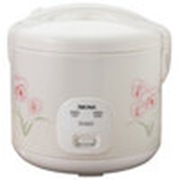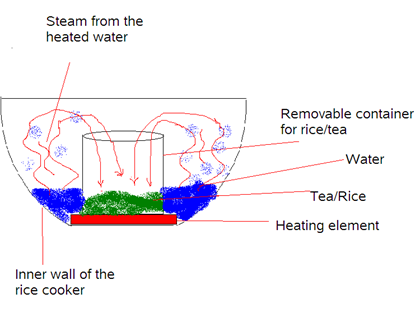First, the equipment. There are many types of rice cookers on the market, some of which are very fancy and can cook an entire meal at once. My rice cooker is a simple one with two buttons: cook and warm/off. I bought it at Costco 3 years ago for about $40, putting it in the budget category. However, it's simple to operate and has a non-stick interior surface. This type of rice cooker is the most common type currently being used. A small heating element at the bottom of the cooker engages with the metal container holding the rice and water, heating the container and cooking the rice.
The other major type of rice cooker, one that has a cult following, is the Taiwanese Datong/Tatung brand. The type of rice cooker that most people associate with this brand is one in which there is a small, removable, metal container inside of the rice cooker that is quite a bit smaller than the cooker. Rice is placed inside of this small container, which is in turn placed inside the cooker. Water is added not into the container, but into the space between the rice cooker's interior walls and the container. The heating element at the bottom of the cooker heats the water and the rice is cooked by the steam that is generated. Below is my lovely, artistic rendition of the process:
Fans believe that the Tatung steam cookers make rice that is fluffier and have a better texture than through induction-heat cookers. I will say that when my Costco-bought rice cooker makes rice, the top layer is dry because it's without water as the rest of the rice cooks, while the bottom layer is more moist because it's been in contact with water the longest.
Alternatively, the problem with the Tatung cookers is that the rice at the bottom of the container gets too hot and sticks to the bottom, often turning brown. Many people do not mind this; my friends' dad likes to pick it out and eat it like a wafer. With Korean stone pot rice at restaurants, the waitress will bring tea for you when you've finished your rice so that you can mix it with the hard rice that is stuck to the bottom, turning it into a light rice soup. In Cantonese claypot rice dishes, the crunchy, stuck-on rice at the bottom of the bowl has a texture that many people love.
In Part 2, which will probably not be the next post, I'll talk about some of my initial experiences with rice cooker tea roasting. Look for it!











No comments:
Post a Comment